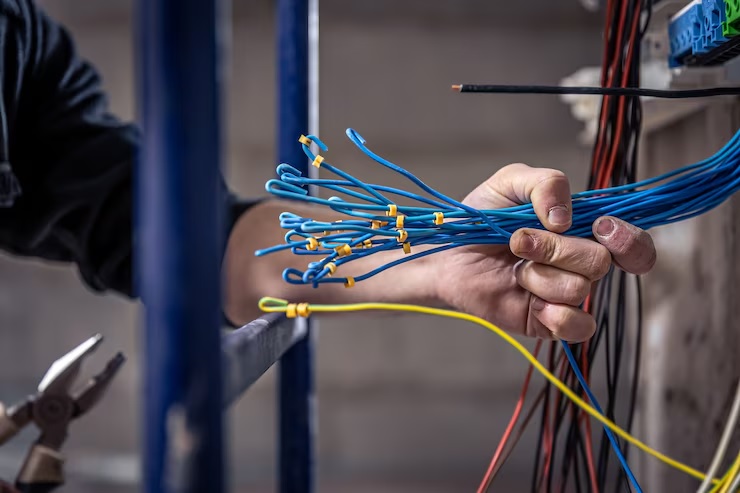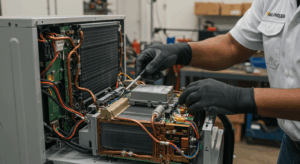Step onto the floor of a busy cable factory, and you’ll see a hive of activity. Heavy machinery hums, large drums of cable are maneuvered, and processes involving high heat or sharp materials are underway. While producing the essential cables that connect our modern world, like the rapidly developing infrastructure across India, these environments inherently carry risks for the dedicated workforce. Prioritizing worker safety isn’t just a regulatory requirement; it’s a moral imperative. Thankfully, technology, specifically automation and robotics, is stepping up to tackle the most dangerous and physically taxing jobs, creating significantly safer working conditions.
Understanding the Risks on the Factory Floor
Making cables involves several potential hazards that automation can help mitigate:
- The Strain of Heavy Lifting: Moving massive drums or reels of finished cable, which can weigh several tonnes, is a primary cause of musculoskeletal injuries (back strains, sprains). Handling heavy coils of raw materials like copper wire also poses ergonomic risks.
- Repetitive Motion Injuries: Tasks like manually coiling smaller cables, repeatedly cutting specific lengths, or packing finished goods can lead to conditions like carpal tunnel syndrome or tendonitis over time.
- Exposure to High Temperatures: Processes like polymer extrusion generate intense heat. Working close to these machines can lead to burns or heat stress.
- Sharp Materials & Moving Machinery: Handling raw wire, using cutting tools, and operating complex machinery always present risks of cuts, abrasions, pinching, or entanglement if safety protocols lapse.
- Electrical Hazards: High-voltage testing of certain cable types requires stringent safety measures to prevent electrical shock.
While rigorous training and safety procedures are fundamental, automation provides a powerful way to engineer these hazards out of many routine tasks.
How Robots and Automation Become Safety Allies
These technologies aren’t primarily about replacing people; they’re about taking over tasks where humans are most vulnerable:
1. Handling the Heavy Loads
- Robotic Drum Handling: Large industrial robots equipped with specialized grippers can effortlessly lift, rotate, stack, and palletize heavy cable drums, removing the need for manual handling or complex forklift maneuvers in potentially congested areas.
- Automated Guided Vehicles (AGVs): These smart, self-driving platforms can transport heavy reels of raw materials or finished goods across the factory floor autonomously, reducing manual pushing/pulling and minimizing traffic hazards.
2. Eliminating Repetitive Strain
- Automated Coiling/Spooling Machines: These systems precisely wind cables onto smaller reels or into coils, measuring length and maintaining tension automatically, freeing workers from tedious, repetitive manual winding.
- Robotic Cutting & Assembly: Robots can perform repetitive tasks like cutting cables to exact lengths, potentially applying simple connectors, or packing products, reducing the risk of RSIs for human workers.
3. Creating Distance from Danger Zones
- Heat-Resistant Robots: Robots can operate reliably in the high-temperature zones immediately around extrusion lines, handling material loading or initial product manipulation where it would be unsafe or uncomfortable for humans.
- Hazardous Material Handling: In processes involving specific chemicals (e.g., certain additives or cleaning agents), robots can manage the handling, mixing, or application, minimizing worker exposure.
4. Making Machine Interaction Safer
- Robotic Machine Tending: Robots can load raw materials into machines (like wire drawing blocks or extruders) and unload finished or semi-finished products, keeping human hands clear of moving parts, rotating components, and potential pinch points during operation.
- Integrated Safety Systems: Modern automated systems often incorporate advanced safety features like light curtains, safety mats, or area scanners. If a person enters a designated danger zone while the machine is active, these systems trigger an immediate, safe stop.
5. Consistent Quality Checks from a Safe Distance
- Automated Vision Inspection: High-speed cameras linked to analysis software can continuously scan cables for surface defects, dimensional accuracy, or print quality without requiring close manual inspection near moving machinery.
- Inline Testing: Automated electrical tests (like spark testing for insulation integrity) can be integrated directly into the production line, performing checks without manual intervention in potentially high-voltage areas.
Automation: More Than Just Safety
While enhancing worker safety is a primary driver, implementing automation yields other significant advantages:
- Increased Productivity: Robots can often perform tasks faster and operate continuously without fatigue.
- Improved Product Consistency: Automated processes reduce human variability, leading to more uniform cable quality.
- Reduced Errors: Automation minimizes mistakes in repetitive tasks like cutting lengths or counting items.
Implementing Automation Thoughtfully
Bringing automation and robotics into a factory requires careful consideration:
- Investment: The initial cost of robotic systems and their integration can be substantial.
- Skills & Training: The workforce needs to be trained to operate, supervise, and maintain these new automated systems safely and effectively. New technical skills may be required.
- Thorough Risk Assessment: Before implementation, a detailed risk assessment is crucial to ensure the automation itself is safe and doesn’t introduce new, unexpected hazards.
- Integration Expertise: Ensuring new automated systems work seamlessly with existing machinery and control systems requires technical expertise.
Leading cable manufacturers in uae, like those globally, recognize that investing in automation is an investment in both their people’s safety and their operational efficiency. Ensuring these systems use reliable components, potentially sourced from quality cable suppliers in uae who understand the demands of automated environments, is also key.
Conclusion: Building Safer Factories, Together
Automation and robotics are powerful tools for transforming worker safety within the cable manufacturing industry. By strategically deploying these technologies to handle the most hazardous, physically demanding, and repetitive tasks, companies can significantly reduce the risk of injuries and create healthier, more sustainable working environments. This evolution isn’t about replacing the human element but enhancing it, allowing workers to focus on higher-level tasks requiring judgment and skill, while technology tackles the dangers. The result is a safer, more efficient, and more productive future for cable manufacturing.
Your Safety Automation Questions Answered (FAQs)
- Will automation lead to job losses in cable factories?
While automation changes job roles, it doesn’t always mean fewer jobs overall. It often shifts workers from manual, high-risk tasks towards roles involving operating, monitoring, programming, and maintaining the automated equipment, or performing more complex quality assurance tasks. Upskilling the workforce is key. - What are the most significant safety improvements from using robots?
Major improvements include a dramatic reduction in musculoskeletal injuries caused by lifting heavy items, minimization of repetitive strain injuries from monotonous tasks, and removing workers from direct exposure to hazards like extreme heat, moving machine parts, or potentially harmful substances. - Is investing in factory automation financially viable for most companies?
While the initial capital expenditure is significant, many companies find a strong return on investment over time. This comes from reduced costs associated with workplace injuries (compensation, lost workdays), lower material scrap rates due to improved consistency, and increased overall productivity. - What specific types of robots are common in cable manufacturing?
Common types include large, articulated robotic arms (similar to those in automotive plants) for heavy tasks like handling large drums; smaller, faster robots for repetitive tasks like packing or machine tending; and Automated Guided Vehicles (AGVs) for transporting materials around the facility. - How do safety systems like light curtains work with robots?
A light curtain creates an invisible barrier of infrared beams around a hazardous area (like a robot’s workspace). If a person or object breaks any of these beams while the system is active, it instantly sends a stop signal to the robot and associated machinery, preventing potential collisions or injuries.






